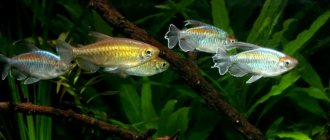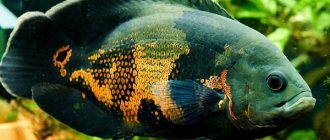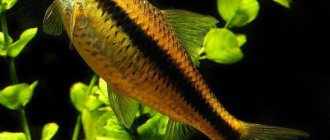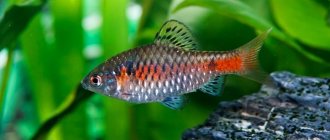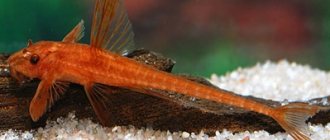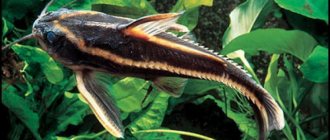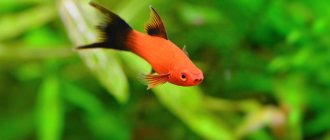The snakehead is a popular aquarium inhabitant among exotic lovers. Freshwater fish of the snakehead family (Channidae). Externally, the fish resembles a snake and is distinguished by aggressive behavior, but this is only one side of the coin. Beautiful and large snakeheads have special habits; it is always interesting to watch them. Some fish grow too large to be kept at home, while others are quite accessible to experienced aquarists.
Aquarium snakehead fish
Living in the wild
Due to the diversity species , we can talk about the diversity of their habitat. Some species live in subtropical waters (Iran, China, Afghanistan, etc.), others are found in equatorial zones (India, Africa). Some snakeheads were able to take root in southern Siberia and the USA. Fish for aquarium keeping are exported mainly from India, Southeast Asia, and Congo.
Snakehead
Appearance of a snakehead
The fish has a thin, elongated body, the head is similar in color and shape to a snake (as if covered with small scales). Depending on the species, the appearance of the snakehead may differ: some have a more elongated snout, others do not have an anal fin , and others are especially long when compared with their counterparts.
The body color of a snakehead can vary
Note ! Body color also depends on the species, but in general terms it looks like this: thin small patterns on a contrasting background.
Snakeheads for the aquarium
Video – Channa marulioides
Lepidosiren paradoxa "Gold")
Lepidosiren - or American scalefish, is a very unusual lungfish native to the reservoirs of America. Its peculiarity is the ability to breathe oxygen in the air and hibernate during the dry season. Lepidosirens grow over 1 meter and are a decoration for show aquariums! They have a long, powerful, rounded body covered with mucus instead of scales. The pectoral and anal fins have the form of cords. The eyes are very small and inconspicuous. The color of the fish is gray-brown, with yellow spots present in young individuals.
Despite its exoticism, lepidosiren is quite unpretentious. Among its neighbors it prefers the company of calm, large, non-aggressive fish. Can be combined with angelfish, discus, and stingrays.
Popular species of snakehead
Let's consider which species of snakehead are especially popular among lovers of aquarium exotics.
Table. Common species of snakehead.
| Name, photo | Short description |
| It is the largest representative - its body length can reach 60 cm. The imperial snakehead does not tolerate neighbors. The body is light below, dark above; the transition between colors is clear and contrasting. Red eyes. Due to its large size, it is rarely found in aquariums. |
| A beautiful and large predatory fish with a body compressed from the sides (which makes it look like ordinary fish). Also called the three-spotted snakehead, the ocellated snake gets its title from the large black spots on its side. Body color is gray-silver. The length is about 45 cm, and therefore the fish is kept only in large aquariums. |
| The most popular species of snakehead due to its size (does not grow more than 15 cm). A relatively peaceful fish: it does not bother its relatives, as well as those larger than it. Often kept in a small flock. But during spawning , aggression still manifests itself, so a pair ready for mating must be removed. |
| The most aggressive species towards its neighbors, especially in closed aquarium conditions. Although in the wild, the red snakehead hunts with pleasure and keeps surrounding aquatic organisms , including relatives, at bay. Body length is 15-20 cm. |
| Also an inveterate aggressor. Due to its elongated body and wide-opening lower jaw, it is similar to an arowana. The body length is 15-20 cm. It does not tolerate any neighbors except snakeheads. Needs a spacious aquarium with shaded areas: location of the tank in the shade, plenty of foliage, etc. |
| A shy fish that grows up to 20 cm. The muzzle is more rounded than that of other snakeheads. It is distinguished by a closed lifestyle in the aquarium - it hides in shelters. The color is turquoise, the rays on the fins are shaded. |
| An inhabitant of southern India, growing up to 40 cm. The body color of adult individuals is rich brown, with lighter fins. Suitable for consumption, therefore it is an object of fishing. Also known as the red-banded snakehead (juveniles may have a red stripe along their body). |
| It poses a serious danger to most fish: with a body size of up to 40 cm, this snakehead willingly devours everyone who fits into its huge mouth. He is also very similar to a snake, very resourceful and agile. Body color is a combination of yellow and blue. |
| Grows up to 30 cm. Gets along with its own kind, but is aggressive towards its neighbors. It has a dark blue body color, fins are black and white, contrasting. There are also small oblong spots of golden color scattered across the body. |
Video – Snakehead Channa pulchra
Keeping a snakehead in an aquarium
First of all, the snakehead is, as noted above, a fairly large aquarium fish. Therefore, it can be kept only if you have a spacious aquarium . We also note that many representatives of the Channidae family tolerate oxygen deficiency well. These fish are successfully bred in the irrigation canals of Southeast Asia. However, in order for the snakehead to feel comfortable, it is necessary to provide suitable conditions.
Asian channa snakehead
Aquarium requirements for snakeheads
Let's look at what an aquarium for Channidae fish should be like.
Aquarium requirements for snakeheads
Table. Basic requirements for an aquarium.
| Parameter | Primary requirements |
| Volume | For dwarf species that grow no more than 15 cm, a 150 liter aquarium is enough. Larger representatives need a large-scale aquarium (minimum 300 liters per individual). There are also requirements for the shape of the tank - it must be both long and wide so that the snakehead can turn around in it. |
| Lid | It must be mandatory. The snakehead is sneaky, resourceful and very jumping; it can easily jump out of the aquarium even when changing the water. |
| Priming | The best option for aquarium soil is gravel with a fraction of 5-7 mm (it is easy to care for). |
| Living plants | They should create shaded areas in the aquarium. Snakeheads do not like bright lighting, preferring dim biotopes . We recommend planting the plants themselves in the ground using separate pots. |
| Aeration and filtration | In this case they are mandatory. Snakeheads are not known for their cleanliness, and therefore it is necessary to choose a filter especially carefully. As for aeration, it is needed to maintain water parameters. Snakeheads themselves breathe mainly atmospheric air, swallowing it from the surface. |
| Decor | For small species, you need to provide shelter: piles of stones, ceramic tubes, jugs, pots. Large species of snakehead are not very demanding in terms of design, but it is still better to arrange caves for them. |
Channidae
Required water parameters
The water in the aquarium should have the following parameters:
- acidity 5.5-7.5 pH;
- hardness 7-15°;
- temperature 26-28°C.
About maintenance and care
To ensure comfortable conditions, follow a few simple rules.
- At least once a month it is necessary to clean the soil with a siphon (if the aquarium is 150 liters, then 2 times).
- Every week you need to change a small amount of water (about 1/10).
Water changes need to be done every week
Freshwater pipefish (Microphis brachyurus)
The freshwater pipefish is a wonderful, delicate fish that is not often found in home aquariums. It comes from the reservoirs of India, Japan, and Madagascar. The needle has a thin, elegant, long body; on the head there is an elongated snout, adapted for sucking food. The color is not bright, sandy brown. Freshwater needles grow about 20 cm. An aquarium of 80 liters or more is suitable for them. A prerequisite for keeping these unusual fish is the presence of a large number of living plants in the aquarium - a comfortable environment for a quality life. Needles are timid and fearful creatures. It is recommended to keep them in a mono-species aquarium, or with equally calm, non-aggressive fish.
Feeding a snakehead in an aquarium
This is a predatory fish that at home feeds exclusively on animal food . These can be pieces of pollock, shrimp, pangasius fillet. To dilute the diet, specially prepared bovine heart is used. Dry food is suitable only for dwarf varieties, and only as an occasional supplement. Small live fish will serve as a treat and incentive to hunt.
Snakehead eats animal food
On a note ! Adults need to be fed 1-2 times a week. We advise you not to overfeed this predator.
Calamoicht (Erpetoichthys calabaricus)
Kalamoicht is perhaps the most “snake-like” fish in the home aquarium, originally from West Africa. Kalamoikht looks very similar to a snake: a long, rounded body, a slightly flattened head, large scales, greenish-brown color. On the head of the kalamoichta there are sensitive outgrowths that serve as organs of touch.
In nature, fish grow up to 90 cm, in captivity they are usually smaller. They require aquariums from 200 liters. Kalamoikhtas are able to live together in a flock. Small fish around them will be perceived as food, but they get along well with mobile, proportionate or “inconvenient to swallow” fish (for example, angelfish).
Kalamoikhts can escape. The aquarium should always be tightly closed!
Compatibility and Behavior
The snakehead is so aggressive that it can even bite its owner. However, he is intelligent, like many large fish, and therefore usually gets used to and loves the one who gives food (sometimes even takes food from his hands).
Snakeheads are aggressive
In an aquarium, fish often live near the bottom in a shaded area. It floats to the surface to become saturated with oxygen.
Regarding the neighborhood, there is a single rule: neighbors should not put the snakehead in the mouth, otherwise sooner or later they will be eaten . Snakeheads rarely fight for territory; the main motivation for aggression is food. Although representatives of some species do not get along even with their relatives.
On a note ! Dwarf snakeheads get along with astronotus and other large cichlids, as well as with royal bots. Ideally, all fish should be introduced into the aquarium at a young age and at the same time - this will increase the likelihood that they will live to an old age.
Astronotuses
Breeding Features
In a flock of several snakeheads, only one pair can form by the age of 4 years. If so, then for the rest it is better to find another home, since due to the onset of puberty, the fish become aggressive towards their relatives.
Snakehead reproduction
How do snakeheads reproduce?
At home, fish will spawn at a temperature of 27°C. Actually, that’s all – no other special parameters or conditions are required. Females lay eggs on leaves or on a nest of bubbles specially built for this purpose. Some species brood eggs in their mouths. Then, after fertilization, the male takes care of the eggs. By the way, it is better to remove the female, since the male can even see her as a threat to the offspring.
Important ! The fry appear on the 5th day maximum. The male protects them for about 2 more weeks, then it is better to place the babies.
Diseases of snakeheads
Fish have fairly good immunity. Adults can develop parasites - they appear in the aquarium when using untested contaminated food. If conditions are very poor, infectious diseases may develop.
Adults can get parasites
Prevention measures are extremely simple: follow all the rules of care and maintenance, regularly change the water, use only clean equipment and quarantine all new fish that enter the aquarium (including those intended for food). The quality of food should be given special attention.
On a note ! Snakeheads are sensitive to sudden changes in water parameters, and therefore you should not replace too large a volume at one time. It is better to do this more often, but in small quantities.
Freshwater moray (Gymnothorax tile)
The freshwater moray eel is a very unusual pet for the home aquarium. In nature, it lives in brackish river estuaries in India and Indonesia. This fish has a long, rounded body with a narrowed muzzle, skin without scales, and covered with protective mucus. The color of the fish is brownish or grayish. Moray eels grow up to 60 cm. These are typical ambush predators. Adults should be kept alone due to their territoriality. Moray eels live well in completely fresh water, but adding salt to 5 ppm improves the quality of life of these fish. Among their neighbors, moving, not small fish, such as argus, monodactyls, will join them in company - they also react positively to low salinity of water. The required volume of an aquarium for moray eels is from 200-300 liters. The lid must always be closed!
Curious facts about snakeheads
- Certain species living close to the equator often experience drying out of water bodies. In this case, the snakehead can either burrow deep into the silt and wait out the drought, or crawl overland into a nearby puddle.
- The snakehead has structural features of its respiratory apparatus that allow it to breathe atmospheric oxygen . Therefore, there should be a space of 5-7 cm between the aquarium lid and the surface of the water.
- In some countries, there is entertainment - sport fishing for snakeheads.
- Snakeheads are raised for food in special ponds. Commercial species have tasty meat.
Snakeheads can breathe atmospheric air
Human use
People use snakeheads for food; large specimens weighing over 20 kg have a lot of tasty, nutritious and fatty meat. The fishing process is also entertaining and more like hunting. A special rubber frog is used as bait.
The bite starts in the afternoon and lasts until late in the evening. Fishermen on rubber boats move along or against the flow of the river. Sometimes the predator is not in the mood and may not take the bait just because of the wrong direction.
When biting, behavior can also be different. Sometimes the fish plays around with the bait, sometimes grabbing it and then letting it go. It is worth considering that the power of the predator is great, so it is better to hold the fishing rod while standing.
